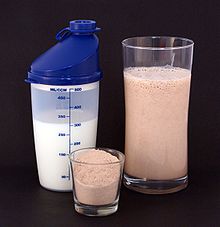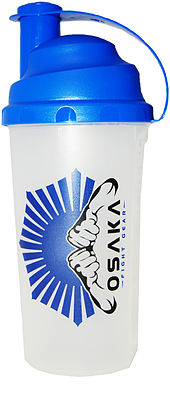Bodybuilding supplement
This article needs more primary sources. (November 2016) |  |
Bodybuilding supplements are
Supplements are sold either as single ingredient preparations or in the form of "stacks" – proprietary blends of various supplements marketed as offering synergistic advantages.History
In the 1910s,
In October 1994, the
Protein

- branched-chain amino acids. It also has the highest content of the amino acid cysteine, which aids in the biosynthesis of glutathione. For bodybuilders, whey protein provides amino acids used to aid in muscle recovery.[15] Whey protein is derived from the process of making cheese from milk. There are three types of whey protein: whey concentrate, whey isolate, and whey hydrolysate. Whey concentrate is 29–89% protein by weight whereas whey isolate is 90%+ protein by weight. Whey hydrolysate is enzymatically predigested and therefore has the highest rate of digestion of all protein types.[15]

Some nutritionists have suggested that higher calcium excretion may be due to a corresponding increase in protein-induced calcium absorption in the intestines.[16][17][18]
Amino acids
Some bodybuilders believe that amino acid supplements may benefit muscle development, but consumption of such supplements is unnecessary in a diet that already includes adequate protein intake.[19]
Prohormones
An androgen prohormone, or proandrogen, is a
Since 2005, the use of steroid precursors (prohormones) has been illegal in the U.S.[21]
Creatine
Some studies have suggested that consumption of creatine with protein and carbohydrates can have a greater effect than creatine combined with either protein or carbohydrates alone.[27]
While generally considered safe, long-term or excessive consumption of creatine may have an adverse effect on the
β-Hydroxy β-methylbutyrate
When combined with an appropriate exercise program, dietary supplementation with
The inhibition of exercise-induced skeletal muscle damage by HMB is affected by the time that it is used relative to exercise.[29][33] The greatest reduction in skeletal muscle damage from a single bout of exercise appears to occur when calcium HMB is ingested 1–2 hours prior to exercise.[33]
Controversy
This article reads like a press release or a news article and may be largely based on routine coverage. (February 2020) |
Mislabeling and adulteration
While many of the claims are based on scientifically-based physiological or biochemical processes, their use in bodybuilding parlance is often heavily colored by bodybuilding lore and industry marketing and, as such, may deviate considerably from traditional scientific usages of the terms. In addition, ingredients listed have been found at times to be different from the contents. In 2015, Consumer Reports reported unsafe levels of arsenic, cadmium, lead, and mercury in several of the protein powders that were tested.[35]
In the United States, the manufacturers of dietary supplements do not need to provide the Food and Drug Administration with evidence of product safety prior to marketing.
In 2015, a CBC investigative report found that protein spiking (i.e., the addition of amino-acid filler to manipulate analysis) was not uncommon;[40] however, many of the companies involved challenged these claims.[40]
Health problems
This section's tone or style may not reflect the encyclopedic tone used on Wikipedia. (September 2020) |
The US FDA reports 50,000 health problems a year due to dietary supplements
The incidence of liver damage from herbal and dietary supplements is about 16–20% of all supplement products causing injury, with the occurrence growing globally over the early 21st century.[2] The most common liver injuries from weight loss and bodybuilding supplements involve hepatocellular damage and jaundice. The most common supplement ingredients attributed to these injuries are catechins from green tea, anabolic steroids, and the herbal extract, aegeline.[2] Other products by supplement designer and CEO of Driven Sports, Matt Cahill, have contained dangerous substances causing blindness or liver damage, and his pre-workout supplement Craze was found to contain illegal stimulants[44] that resulted in several athletes failing drug tests.[45]
Protein effectiveness
Some have argued that there is little evidence to indicate any benefit to using bodybuilding protein or amino acid supplements. A 2005 overview concluded that "[i]n view of the lack of compelling evidence to the contrary, no additional dietary protein is suggested for healthy adults undertaking resistance or endurance exercise".[13]
In contrast, a 2018 systematic review, meta-analysis and meta-regression concluded that, “Dietary protein supplementation significantly enhanced changes in muscle strength and size during prolonged RET in healthy adults.“ (RET is an abbreviation for resistance exercise training.)[46]
See also
Notes
- 3-methylhistidine.[29][32][33] When exercise intensity and volume are sufficient to cause skeletal muscle damage, such as during long-distance running or progressive overload, HMB supplementation has been demonstrated to attenuate the rise in these biomarkers by 20–60%.[29][33]
References
- from the original on 2021-07-29. Retrieved 2021-07-29.
- ISBN 978-0-415-86279-0.
- JSTOR 27840828
- (PDF) from the original on 2016-03-04. Retrieved 2012-01-10.
- S2CID 14586881.
- PMID 17213878.
- PMID 18577776.
- S2CID 8141005.
- S2CID 16708689.
- S2CID 33218998.
- S2CID 27679614.
- ^ ISBN 978-0-309-08525-0. Archivedfrom the original on 2019-08-14. Retrieved 2017-01-01.
- ^ https://www.health.harvard.edu/blog/how-much-protein-do-you-need-every-day-201506188096#:~:text=The%20Recommended%20Dietary%20Allowance%20(RDA,meet%20your%20basic%20nutritional%20requirements. Harvard Medical School , Harvard Health Publishing. “How much protein do you need every day?” Reviewed by Howard E. LeWine, MD, Chief Medical Editor, Harvard Health Publishing. June 22, 2023.
- ^ PMID 10919959.
- PMID 12936953.
- PMID 12612169.
- PMID 15001604.
- ISBN 978-0-17-650258-4.
- ISBN 978-0-444-51830-9.
- ^ Friedel, Angelika, et al. "17β-hydroxy-5alpha-androst-1-en-3-one (1-testosterone) is a potent androgen with anabolic properties." Toxicology letters 165.2 (2006): 149-155.
- ISSN 0731-5724.
- PMID 10731009.
- S2CID 8455503.
- PMID 14561278.
- S2CID 6304255.
- PMID 8944667.
- ^ "Creatine". Mayo Clinic. Archived from the original on 2020-12-09. Retrieved 2020-12-16.
- ^ S2CID 45124293.
Wilson et al. [91] demonstrated that when non-resistance trained males received HMB pre-exercise, the rise of lactate dehydrogenase (LDH) levels reduced, and HMB tended to decrease soreness. Knitter et al. [92] showed a decrease in LDH and creatine phosphokinase (CPK), a byproduct of muscle breakdown, by HMB after a prolonged run. ... The utility of HMB does seem to be affected by timing of intake prior to workouts and dosage [97].
- ^ PMID 26169182.
- ^ (PDF) from the original on 2021-11-24. Retrieved 2020-09-01.
In conclusion, HMB treatment clearly appears to be a safe potent strategy against sarcopenia, and more generally against muscle wasting, because HMB improves muscle mass, muscle strength, and physical performance. It seems that HMB is able to act on three of the four major mechanisms involved in muscle deconditioning (protein turnover, apoptosis, and the regenerative process), whereas it is hypothesized to strongly affect the fourth (mitochondrial dynamics and functions). Moreover, HMB is cheap (~30– 50 US dollars per month at 3 g per day) and may prevent osteopenia (Bruckbauer and Zemel, 2013; Tatara, 2009; Tatara et al., 2007, 2008, 2012) and decrease cardiovascular risks (Nissen et al., 2000). For all these reasons, HMB should be routinely used in muscle-wasting conditions especially in aged people. ... 3 g of CaHMB taken three times a day (1 g each time) is the optimal posology, which allows for continual bioavailability of HMB in the body (Wilson et al., 2013).
- ^ S2CID 22657268.
HMB, a derivative of leucine, prevents muscle damage and increases muscle strength by reducing exercise-induced proteolysis in muscles and also helps in increasing lean body mass. ... The meta analysis studies and the individual studies conducted support the use of HMB as an effective aid to increase body strength, body composition, and to prevent muscle damage during resistance training.
- ^ PMID 23374455.
- PMID 26010896.
- ^ McGinn D (7 November 2010). "Are protein shakes the weight-loss magic bullet? - The Globe and Mail". Theglobeandmail.com. Archived from the original on 2 June 2016. Retrieved December 11, 2015.
- ^ a b "Body-building Products and Hidden Steroids: Enforcement Barriers". Food and Drug Administration. Archived from the original on 2015-03-14.
- ^ O'Connor A (21 December 2013). "Spike in Harm to Liver Is Tied to Dietary Aids". The New York Times. Archived from the original on 10 April 2019. Retrieved 26 February 2017.
- PMID 26074745.
- PMID 33371574.
- ^ a b Griffith-Greene M (13 November 2015). "M Some protein powders fail fitness test". Marketplace. CBC News. Archived from the original on 8 September 2017. Retrieved 11 December 2015.
- ^ Offit PA, Erush S (14 December 2013). "Skip the Supplements". The New York Times. Archived from the original on 17 July 2019. Retrieved 26 February 2017.
- ^ "Tainted Body Building Products". U.S. Food and Drug Administration. 17 December 2010. Archived from the original on 23 April 2019. Retrieved 16 December 2019.
- ^ Young A (25 October 2013). "Popular sports supplements contain meth-like compound". USA Today. Archived from the original on 12 November 2019. Retrieved 24 August 2017.
Cohen said researchers informed the FDA in May about finding the new chemical compound in Craze. The team found the compound — N,alpha-diethylphenylethylamine — has a structure similar to methamphetamine, a powerful, highly addictive, illegal stimulant drug. They believe the new compound is likely less potent than methamphetamine but greater than ephedrine.
- ^ "Driven Sports Inc. - 04/04/2014". U.S. Food and Drug Administration. 2019-12-20. Archived from the original on 2021-01-22. Retrieved 2020-12-16.
- ^ Young A (27 September 2013). "Sports supplement designer has history of risky products". USA Today. Archived from the original on 25 June 2019. Retrieved 24 August 2017.
- ^ Morton, Robert W., et al. "A systematic review, meta-analysis and meta-regression of the effect of protein supplementation on resistance training-induced gains in muscle mass and strength in healthy adults." British journal of sports medicine 52.6 (2018): 376-384.
External links
- "Dietary Supplement Health and Education Act of 1994". U.S. Food and Drug Administration. 4 February 2020.
